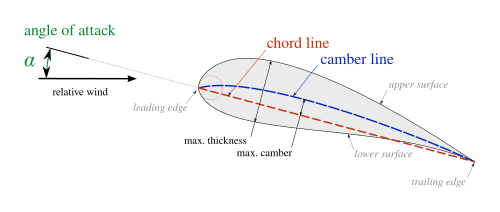HOW DO AIRPLANES FLY

According to Bernoulli's theorem, In any ideal fluid (without viscosity or friction), incomprehensible, in laminar regime of circulation through a closed conduit, the energy that has the fluid remains constant throughout its entire journey. In our case we will focus in the pressure. There are two types of pressure, the static and the dynamic, and the addition of these will be constant in all of points of the route. The dynamic pressure depends of the density and the velocity, and this velocity increase when the fluid of air passes by the narrowing formed in the top of the wing, this increase of the velocity lowers the static pressure, and this difference of pressures between the top and the bottom of the wing is the fact what makes it fly.
 The difference of pressure varies according the profile of the wing, we can take into account:
The difference of pressure varies according the profile of the wing, we can take into account:-Leading edge: the edge more advanced.
-Trailing edge: the edge more delayed.
-Chord: line that links the leading edge with the trailing edge.
-Camber: it tells us how curved it is.
-Thickness: distance between the top and bottom of the wing.
-Angle of attack: the angle between the chord and the relative wind.
-Angle of incidence: the angle between the chord and the aircraft..
We will also take into account the form of the wing: fineness, elongation and narrowing.
In the aircraft we have four forces:
-The lift:it's the force that we get with the wings. This does the aicraft goes up.
-The thrust: it's the force that we get with the engines. It will moves us forward.
-The drag: the resistence that opposes the plane to be move.
-The weight: it's the sum of the masses that makes us fall because the force of gravity.
When this four forces are in balance the aircraft is in cruising speed. For the take off we need more thrust (increasing the power of the engines) and more lift (increasing the leading angle). In the landing we need decrease the thrust and the lift.
 To control the differents moviments of the plane we have three axes:
To control the differents moviments of the plane we have three axes:-Longitudinal axis: the motion about this axis is called roll, a positive rolling motion lifts the left wing and lowers the right wing. Controlled by the ailerons.
-Vertical axis: Motion about this axis is called yaw, a positive yawing motion moves the nose of the aircraft to the right. Controlled by the rudder.
-Lateral axis: Motion about this axis is called pitch, a positive pitching motion raises the nose of the aircraft and lowers the tail. Controlled by the elevators.
The capacity to return to its balanced position is called stability, we have two types:
-Static stability: Static stability is the initial tendency of an aircraft to return to its original position when it's disturbed.
-Dynamic stability: Dynamic stability is how an airplane responds over time to a disturbance.


Comments
Post a Comment